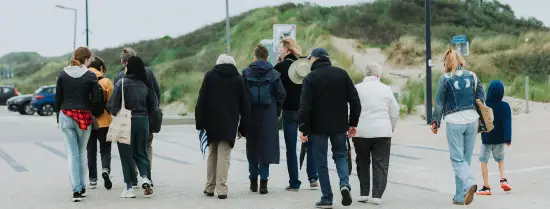
How did a researcher in strategic management and a researcher in urban creative trades end up working together? A shared interest in the historical development of the port and the city brought Maurice Jansen, researcher at the Erasmus Centre for Urban, Port and Transport Economics, and Amanda Brandellero, associate professor and head of department of Arts & Culture Studies, together. 'We’re looking at the same area in the port from different perspectives', and that’s what makes this interdisciplinary collaboration so valuable.
The port is inextricably linked to Rotterdam and the surrounding towns. The history of the port and the city is connected to the entrepreneurs and businesses that have been located there over the years. It’s a phenomenon you see all over the world. Amanda Brandellero and Maurice Jansen are each studying it from their respective fields. 'For example, I’m looking at how creative entrepreneurs working in a sustainable and circular way end up in former port areas that are being renovated', Amanda Brandellero says. Areas like RDM and Merwe-Vierhaven are good examples. 'And as a business expert, I wondered what was behind these creative industries', says Maurice Jansen. 'Because, for port developers, this is a new segment.'

What do creative businesses have to offer a major world port?
Developing dilapidated old port buildings, which are often located close to the city, is obviously valuable for local residents and the entrepreneurs themselves. But how do those small businesses contribute to that major world port? 'Established companies realise that, for unbounded innovation, they need young entrepreneurs', Maurice Jansen says. 'Communities of practice and ‘network innovators’ emerge, organising meetings and mobilising capital. As a result, funding is provided for young entrepreneurs, along with the opportunity to bring innovations to a larger company.'
One example is Zepp Solutions, a company that makes portable fuel cells for use on docks, ships and lorries. In the early stages, they were looking for a place to experiment, and they ended up at RDM. When a company scales up, there’s more room for it in Merwe-Vierhaven. After that, the innovation needs to be adopted by established companies in the port.

'Instawalks' through the port
The two researchers also collaborate in the LDE Centre PortCityFutures and the Port Management and Maritime Logistics minor. The minor is mainly taken by Economics and Business students, but students from Leiden University and TU Delft also take part. Maurice Jansen noticed that many students don’t actually know Rotterdam as a port city, so he looked for a creative way to help them discover the port in the city. That’s how the ‘Instawalk’ component of the programme was born. During an Instawalk, students design their own route from a thematic perspective, exploring and photographing the port in the city. 'The aim is to broaden the horizons of the participating students', explains Maurice Jansen. 'And it works. It’s nice to see that Economics students, for example, can turn out to be very creative.'

Conversations while walking
The port Instawalk has been brought to a wider audience. During the Lifelong Learning Festival in May, a group of around ten interested people gathered to explore the relationship between port and nature in Hoek van Holland with Amanda and Maurice. 'That’s a subject on which there are many different opinions', Amanda explains. 'Through the conversations during an Instawalk, you go into a lot of depth, and that can’t be planned in advance. It’s very spontaneous and participatory. By taking part in these conversations, we open ourselves up to knowledge from those who know the area well from their own experience.' Maurice adds: 'People are convinced that I know a lot about the port, but when I hear the stories of the previous generation, I realise that I’m far from knowing everything. These are the deeper layers of the port city, the cultural capital of Rotterdam.' As an example, Amanda mentions that an older participant talked about the smells you used to encounter in Hoek van Holland. A certain wind direction brought a particular smell.
The researchers say they found the experience of the walk very instructive and can see many more opportunities for such walks. In addition, Amanda Brandellero is strengthening relationships with the neighbourhood in Rotterdam South where the future Culture&Campus on Putselaan will be located. Maurice Jansen says he wants to learn more about the collectives of artists, architects and others that have emerged in former port areas. 'How does something like that work? Does it work differently in the beginning, and then change after a few years? Does it become stifling?'
- Researcher
- Researcher
- More information
More stories about entrepreneurship
More information about the minor Port Management and Maritime Logistics
More information about the Erasmus Centre for Urban, Port and Transport Economics
More information about the Cultuur&Campus Putselaan- Related content
